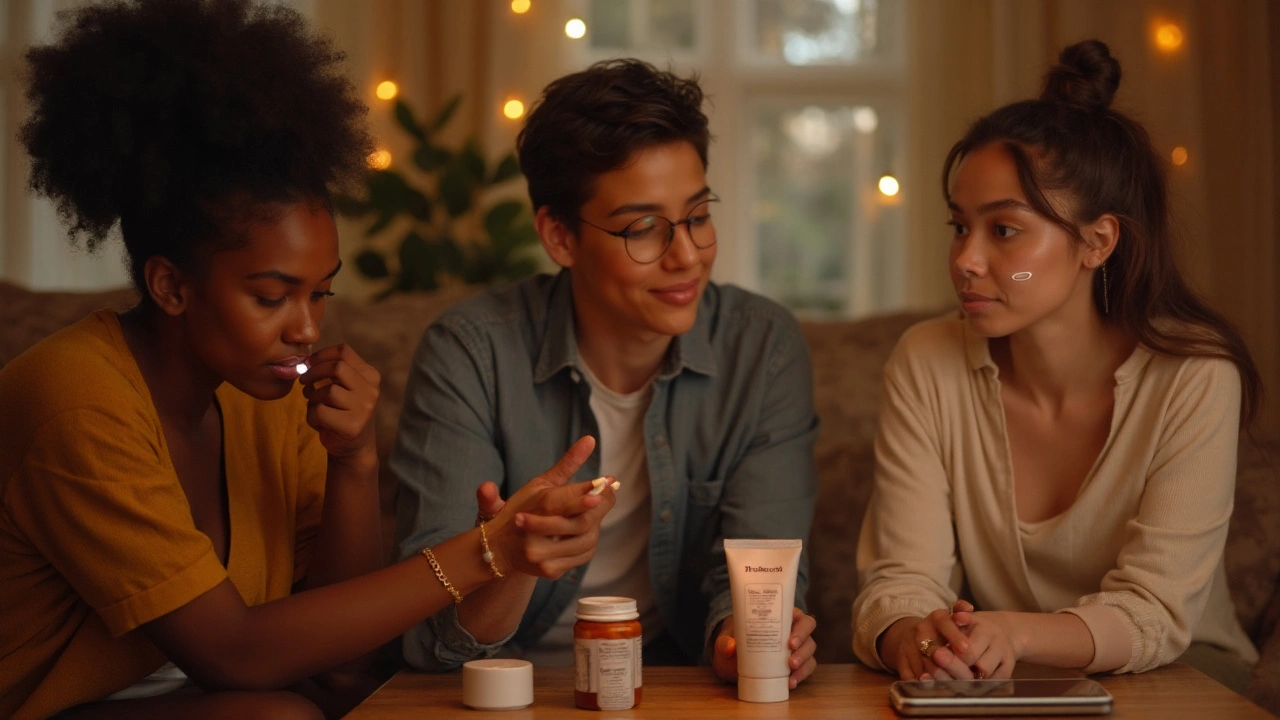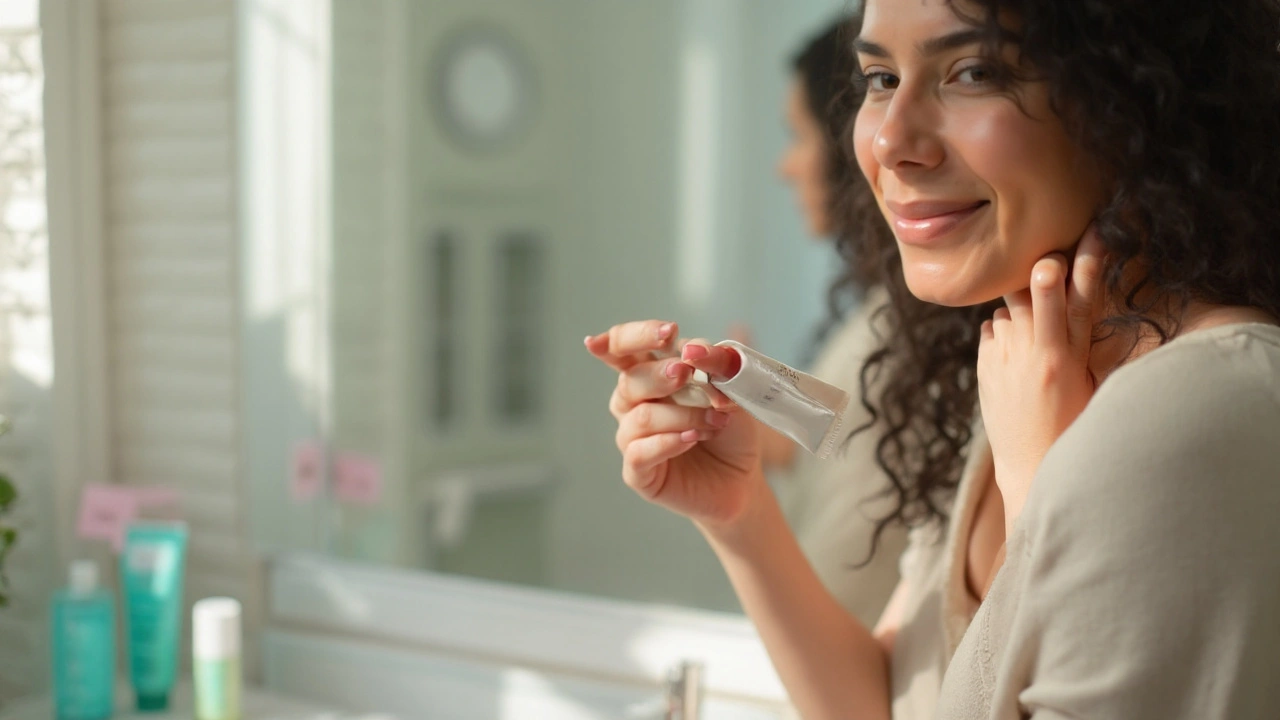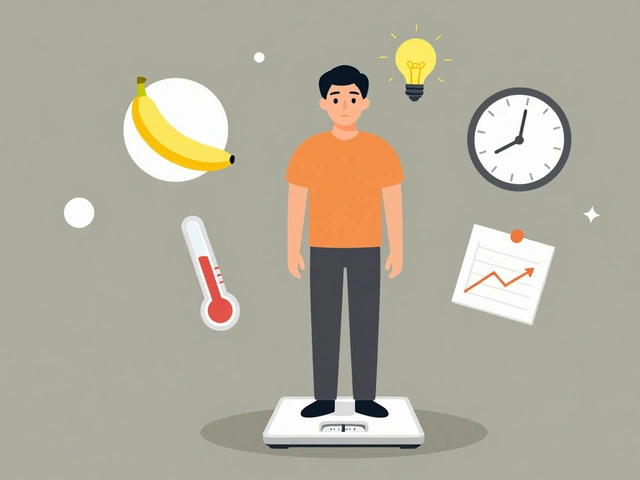If you pick the wrong tretinoin strength, you either quit from irritation or wait months for results that could’ve come sooner. The sweet spot is matching percentage, formula, and pace to your skin type and goals-acne, anti‑aging, or pigment. Expect 8-12 weeks for visible change and some dryness at first. With the right start, you can keep your barrier happy and still get the glow.
- Start lower if you’re sensitive or new (0.025%), mid if you’re average (0.05%), and high only when well‑tolerated (0.1%).
- Use a pea-sized amount, 2-3 nights/week, then build to nightly over 4-8 weeks.
- Creams = gentler; gels = more drying; microsphere/encapsulated = fewer stings.
- Buffer with moisturizer, and wear SPF 50+ daily-especially in Australian sun.
- Reassess at 12 weeks: if clear and calm, you can maintain or step up a level.
The quick path to your ideal strength
Here’s the simple way to decide your first bottle and when to level up. I live in Perth, and between sea breeze and fierce UV, I’ve tested every way to avoid the lizard phase on runs with my golden retriever, Max.
Pick by skin type:
- Dry, sensitive, eczema or rosacea‑prone, or skin of color with post‑inflammatory dark marks risk → start 0.025% cream, 2 nights/week.
- Normal/combination, mild-moderate acne, or first anti‑aging run → 0.05% cream, 2-3 nights/week.
- Oily, resilient, stubborn comedonal acne or plateaued on 0.05% → consider 0.1% after 8-12 calm weeks.
Pick by goal:
- Acne (blackheads/whiteheads): 0.025-0.05% to start; increase if still clogged after 12 weeks.
- Inflammatory acne (red bumps): 0.05% plus benzoyl peroxide in the morning; consider 0.1% if tough and you tolerate well.
- Photoaging (fine lines, uneven tone): 0.05% is the workhorse; it’s the strength used in many photoaging trials.
- Pigmentation (melasma/PIH): go low, go slow-0.025% to minimize irritation‑triggered darkening; combine with SPF and gentle brighteners.
Formula matters:
- Cream: more hydrating, better for dry/sensitive skin.
- Gel: more drying, penetrates faster; suits oily or very comedonal skin.
- Microsphere/encapsulated: trickle‑release, often stings less and is more light‑stable.
Rules of thumb that work in real life:
- When in doubt, start lower. You can always step up; you can’t undo a fried barrier.
- Irritation usually peaks weeks 2-4. Hold steady there; don’t increase yet.
- If you’re peeling more than you’re progressing, treat the dryness first-strength means nothing if you can’t apply consistently.
Why this approach? The American Academy of Dermatology and Cochrane reviews show all topical retinoids improve acne and photoaging; higher strengths can act a bit faster but raise irritation risk. Dermatology guidelines back starting low and titrating to the highest tolerable dose for sustained use.
Australian context: tretinoin is prescription‑only (Schedule 4). Your GP, a derm, or telehealth can prescribe it. It’s commonly available in 0.025%, 0.05%, and 0.1% strengths as cream or gel. The Cancer Council recommends daily broad‑spectrum SPF 50+-non‑negotiable here.
Step‑by‑step: start, titrate, and maintain
This is the routine I give friends who want results without wrecking their skin barrier. It’s simple, boring, and it works.
- Choose your starting tretinoin strength: 0.025% if sensitive or you’ve failed retinol, 0.05% if average skin and motivated, 0.1% only if you’ve already tolerated 0.05% well for at least 8-12 weeks.
- Night 1 setup: cleanse with a gentle, non‑foaming cleanser; pat dry; wait a few minutes until skin is fully dry (reduces sting).
- Buffer if sensitive: apply a thin moisturizer first (“sandwich method”), then tretinoin, then moisturizer again. If not sensitive, go straight onto dry skin.
- Apply: pea‑sized total for the whole face. Dab on forehead, cheeks, chin, nose; spread thinly. Avoid eyelids, corners of nose, and lips at first.
- Frequency: 2 nights/week for week 1. If calm, 3 nights/week for weeks 2-3. Then every other night. Aim for nightly by week 6-8 if your skin is happy.
- Morning: sunscreen SPF 50+ every day. Add a simple moisturizer if dry. If treating acne, benzoyl peroxide 2.5-5% in the morning pairs well; use separate times from tretinoin to minimize irritation.
- Adjust: if stinging or sheets of peeling appear, drop back to the previous frequency, add more moisturizer, and pause exfoliating acids. Resume when calm for 3-4 nights in a row.
- Reassess at week 12: if breakouts are mostly controlled or texture is smoother and irritation is low, you can stay the course. If you want more punch and you’re on 0.025% or 0.05%, discuss stepping up one level.
What about purging? Retinoids speed up cell turnover, so you might unmask micro‑comedones during weeks 2-8. True purging happens where you usually break out and settles by around week 8. New breakouts in brand‑new areas, burning, or persistent redness point to irritation, not purging-slow down.
How much product? A pea for face, a pea for neck, and another if you later include the chest. More isn’t faster; it’s just angrier skin.
When to step up strength:
- After 8-12 weeks of consistent use with minimal dryness.
- If you’re still getting frequent comedones or want more improvement in texture and you’ve handled the current strength well.
- Not during a flare of irritation, harsh winter winds, or after a surf weekend without diligent sunscreen.
When to step down or pause:
- Cracked corners, burning, or stinging that lasts beyond 30 minutes post‑application.
- Active eczema/rosacea flare.
- Planning in‑clinic treatments (peels, lasers). Most derms ask you to stop tretinoin 5-7 days before and a week after.
Safety: Avoid if pregnant or trying to conceive; most guidelines advise against topical retinoids during pregnancy and breastfeeding. If you have a history of severe eczema or very reactive skin, talk to your GP or dermatologist before starting.

Real‑world examples and how to copy them
Example 1: Sensitive, flaky, wants anti‑aging (fine lines, dullness)
- Start: 0.025% cream, 2 nights/week.
- Method: sandwich with a ceramide moisturizer. No acids for the first month.
- Check‑in week 4: if only mild dryness, go to 3-4 nights/week.
- Week 12: if well‑tolerated and wants more, move to 0.05% every other night, then nightly.
Example 2: Oily skin with stubborn blackheads and jawline breakouts
- Start: 0.05% gel, 3 nights/week; morning benzoyl peroxide 2.5%.
- Method: no heavy occlusives at night; light gel moisturizer.
- Check‑in week 8: comedones down but not clear; skin calm. Step to 0.05% nightly.
- Week 12-16: if still clogged, consider 0.1% gel every other night; monitor dryness.
Example 3: Skin of color with post‑acne dark marks (PIH) and mild acne
- Start: 0.025% cream, 2 nights/week to prevent irritation‑driven darkening.
- Method: strict SPF 50+ daily, vitamin C in the morning, no scrubs.
- Check‑in week 6-8: increase to 3-4 nights/week if calm.
- Add‑ons: short‑contact application (apply for 30-60 minutes, then rinse) for the first 2 weeks can reduce sting.
Example 4: Melbourne winter dryness or Perth summer UV
- Dry winter: switch to cream, add a heavier night moisturizer, and drop frequency by one step for 2-3 weeks.
- High UV summer or beach days: keep tretinoin at night, double down on sunscreen and a hat. If you get a sunburn, pause until healed.
Example 5: Mature skin, mainly photoaging, no acne
- Start: 0.05% cream, every other night.
- Method: moisturizer before and after for the first month; avoid harsh toners.
- Expect: smoother texture around week 6-8; fine lines and mottled tone improve by 3-6 months.
Cheat sheets, comparisons, and pro tips
Use these quick references to save guesswork.
| Strength | Best for | Irritation risk | Typical starting frequency | Notes |
|---|---|---|---|---|
| 0.025% | Sensitive/dry skin, skin of color, first‑time users | Low-moderate | 2 nights/week | Great on‑ramp; combine with moisturizer; step up after 8-12 weeks if calm. |
| 0.05% | Normal/combination skin; mild-moderate acne; photoaging | Moderate | 2-3 nights/week | Evidence sweet spot for acne and photoaging; build to nightly if tolerated. |
| 0.1% | Oily/resilient skin; stubborn comedonal acne; plateaus | Higher | Every other night | Use after proving tolerance to 0.05%; watch for dryness and scale back if needed. |
Formulas at a glance:
- Cream vs gel: choose cream if you ever feel tight after washing; gel if you’re shiny by noon.
- Microsphere/encapsulated: worth it if you’ve quit tretinoin before due to sting.
Barrier‑friendly playbook:
- Keep it boring for 4 weeks: cleanser, tretinoin, moisturizer at night; sunscreen in the morning. Add extras later.
- Moisturizer trick: apply to damp skin; look for ceramides, cholesterol, and fatty acids.
- Short‑contact nights: in weeks 1-2, apply for 30-60 minutes, then rinse and moisturize-useful for ultra‑sensitive skin.
What not to mix in the same routine (at least at first):
- Strong acids (glycolic, salicylic) on the same night-alternate nights.
- Scrubs and cleansing brushes-skip for the first month.
- Fragrant oils on irritated skin-can sting and worsen redness.
Pro tips that save faces:
- Apply to bone‑dry skin to reduce sting; if you sweat after a workout, shower, dry, then apply.
- Spot‑prep: dab a thin layer of petrolatum at the corners of the nose and lips to avoid cracks.
- Traveling? Heat degrades tretinoin. Don’t leave it in a hot car-common mistake here in WA summers.
Evidence notes for the cautious:
- Randomized trials show topical tretinoin reduces acne lesions and improves photoaging markers; higher strengths can bring slightly greater or faster gains with more irritation (Journal of the American Academy of Dermatology).
- Guidelines from the American Academy of Dermatology recommend topical retinoids as first‑line for comedonal acne and maintenance, often combined with benzoyl peroxide for inflammatory acne.
- Cochrane reviews support retinoids for acne with moderate certainty of benefit versus vehicle.
- For melasma, triple therapy (hydroquinone + tretinoin + mild steroid) is effective, but irritation can trigger PIH-go gentle and use sun protection (dermatology guidelines).

FAQ and troubleshooting
Is benzoyl peroxide safe with tretinoin?
Yes. Use benzoyl peroxide in the morning and tretinoin at night. Older formulas could be inactivated by peroxide, but modern routines separate them for both efficacy and comfort.
How long until I see results?
Acne: 6-12 weeks for clear improvement; texture and pores: 6-8 weeks; fine lines and tone: 3-6 months. Keep photos under the same light to track progress-you’ll forget how far you’ve come.
Do I need to wait 20-30 minutes after washing?
Not mandatory, but applying to fully dry skin reduces stinging. Even two to three minutes helps.
Can I use around the eyes?
Carefully and later. Once your cheeks tolerate it nightly, you can nudge a small amount to the orbital bone twice a week. Never on the lash line or eyelid until you know your limits.
Will tretinoin thin my skin?
It thins the dead outer layer (stratum corneum) while thickening the living epidermis and boosting collagen over time. The result is usually stronger, not weaker, skin.
Pregnancy and breastfeeding?
Skip topical retinoids if pregnant, trying, or breastfeeding. This is consistent with dermatology and Australian regulatory advice.
Skin of color-will it worsen my dark marks?
Tretinoin helps PIH long‑term, but irritation can darken first. Start low (0.025%), moisturize, avoid scrubs, and ramp slowly. SPF 50+ is your best friend here.
Can I use exfoliating acids with tretinoin?
Yes, but alternate nights. If you’re peeling or stinging, park the acids for a few weeks.
What if I’m peeling like crazy?
Drop frequency, add a bland moisturizer, and try short‑contact application. Resume slowly after 3-4 calm nights. If cracks or persistent burning appear, pause and check with your GP.
Australian availability and cost?
In Australia, tretinoin is prescription‑only. Strengths commonly include 0.025%, 0.05%, and 0.1%. Some products may not be PBS‑subsidised for cosmetic indications; ask your GP or pharmacist about options.
Can teenagers use tretinoin?
Yes, often first‑line for comedonal acne per dermatology guidelines. Start at 0.025% or 0.05% with careful ramping and consistent sunscreen.
When should I see a doctor?
If acne is scarring, cystic, or not improving after 12 weeks, or if you have severe irritation, eczema, or rosacea flares. You might need add‑ons like oral meds or different topicals.
Next steps by persona:
- New to tretinoin, sensitive skin: ask your GP for 0.025% cream; plan 2 nights/week with moisturizer sandwich; set a 12‑week review.
- Acne‑focused, oily skin: 0.05% gel at night, benzoyl peroxide in the morning; reassess at 8-12 weeks; consider 0.1% only if well‑tolerated.
- Photoaging priority: 0.05% cream, every other night to nightly over 6 weeks; pair with vitamin C AM and SPF 50+.
- Skin of color with PIH: 0.025% cream, slow ramp, strict sun protection; add niacinamide and azelaic acid on alternate nights.
Troubleshooting quick fixes:
- Sting within minutes: apply on top of moisturizer for the next 1-2 weeks.
- Flakes around mouth and nose: protect those areas with a thin petrolatum layer before application.
- Breakouts in new areas: reduce frequency; check for pore‑clogging makeup or sunscreen.
- No progress at 12 weeks but zero irritation: discuss stepping up strength or changing formula (cream ↔ gel).
Why you can trust this plan: it mirrors dermatology guidance (AAD, Cochrane) and real‑world practice in Australia under TGA rules. Stick to the cadence, don’t skimp on SPF 50+, and choose the lowest strength that lets you be consistent. That’s how you get clear, smooth, even skin without the misery phase.



 Medications
Medications





Sanjoy Chanda
September 7, 2025 AT 10:14Started 0.025% cream last month after reading this-my skin’s not perfect but it’s not screaming anymore either. Still peeling a little around the nose, but I’m using the petrolatum trick and it’s helping. Been 6 weeks, no major breakouts. I’m just glad I didn’t go full 0.1% like I wanted to. Patience pays.
Also, SPF 50+ isn’t optional here in India either. My face still burns if I forget. Learned that the hard way.
megha rathore
September 9, 2025 AT 07:35OMG I tried this and my skin went FULL LIZARD MODE 😭😭😭 like, flakes everywhere, I thought I was gonna have to wear a scarf to work. I was on 0.05% gel and thought I was ‘tough’. Nope. I cried. Then I switched to 0.025% cream and now I’m alive again. Tretinoin is not a flex. It’s a relationship. You gotta earn it. 💔
prem sonkar
September 11, 2025 AT 00:29so i started 0.025% like u said but i think i might be purging? i got like 5 new pimples on my chin and i dont know if its the tret or just my diet or maybe the new shampoo? i used to use head and shoulders now its dandruff shampoo but its sulfate free so idk. also why does my skin feel like sandpaper? is that normal? or am i just dumb?
Corine Wood
September 11, 2025 AT 18:20This is one of the most thoughtful, grounded guides I’ve read on tretinoin. So many people treat it like a magic bullet, but the real work is in the pacing, the moisturizing, the patience. I’ve seen clients go from terrified to glowing just by following the ‘boring’ routine-cleanser, tret, moisturizer, SPF. No serums, no acids, no drama. Just consistency.
And the ‘pea-sized’ rule? That’s the golden ticket. Most people use way too much. It’s not about coverage-it’s about penetration. Less really is more here.
Also, the microsphere formulations? Worth every cent if you’ve had bad reactions before. They’re like tretinoin on a slow drip instead of a firehose.
Jake TSIS
September 13, 2025 AT 03:49So you’re telling me the government and Big Pharma are pushing tretinoin so we’ll all look ‘perfect’ and stop questioning the system? SPF 50+? Yeah right. That’s just to sell more sunscreen. I’ve been using coconut oil and sunbathing since 2015. My skin’s better than yours. Also, tretinoin is a chemical weapon designed to make you dependent. Wake up.
Also, my cousin’s neighbor’s dog got skin cancer from this stuff. It’s all connected.
Akintokun David Akinyemi
September 14, 2025 AT 13:46Bro, this guide is fire! As a Nigerian with oily skin and PIH, I’ve been on 0.025% cream for 10 weeks now. Started with 2 nights/week, sandwiched with CeraVe. No acids, no scrubs, just SPF 50+ every single day-rain or shine. My dark marks? Fading. Not gone, but fading. And I’m not peeling like a snake anymore.
Pro tip: If you’re in Lagos, buy from licensed pharmacies. Some online sellers sell expired tretinoin. I lost 3 weeks to a bad batch. Don’t be me.
Also, your skin doesn’t need to burn to work. Consistency > intensity. That’s the Nigerian way: slow and steady wins the race.
Jasmine Hwang
September 15, 2025 AT 18:43i used tretinoin for 3 weeks and my face looked like a raisin that got ran over by a truck. i cried in the shower. then i used a face mask i bought on amazon that said ‘miracle repair’ and now i’m ‘glowing’?? idk. i think the tret made me look older and now i’m just sad. also my mom said i look like a ghost. i think she’s right. why do people even do this? i just wanted to be pretty. not a science experiment.
Maeve Marley
September 15, 2025 AT 19:51I’ve been using tretinoin for over two years now-0.05% cream, nightly, since I was 24. I’m 28. My skin has never been better. I’ve had my ups and downs, sure-there was a winter where I had to drop to every other night because of dryness, and I had to pause during a trip to the desert because the wind was brutal. But I never quit.
The key isn’t the strength. It’s the ritual. Nightly moisturizer on damp skin. SPF 50+ like it’s your job. No mixing acids until you’re sure your barrier can handle it. And most of all-don’t compare your week 4 to someone else’s week 12. Everyone’s skin is a different ecosystem.
I used to think retinoids were ‘anti-aging.’ Now I think they’re ‘anti-desperation.’ You stop chasing quick fixes and start trusting the process. That’s the real transformation.
Also, the ‘pea-sized’ rule? Still holds. I’ve seen people use half a teaspoon. That’s not skincare. That’s a crime against skin.
James Gonzales-Meisler
September 16, 2025 AT 03:14The post is well-structured, clinically accurate, and aligns with current dermatological guidelines. However, the use of ‘lizard phase’ is colloquially inappropriate and diminishes the clinical gravity of retinoid-induced irritation. Additionally, the phrase ‘you can’t undo a fried barrier’ is imprecise-barrier dysfunction is reversible with proper intervention, though it may take months. Terminology matters.
Steve Harvey
September 16, 2025 AT 12:50Wait-so you’re telling me tretinoin is safe if you use SPF? That’s what they want you to think. But what if the sunscreen has nanoparticles? What if the SPF 50+ is just a placebo? What if the real cause of your wrinkles is 5G radiation and the tretinoin is just masking the symptoms? I’ve been tracking my skin under UV light. The redness? That’s not irritation. That’s your body rejecting the chemical assault.
Also, I know a guy who used tretinoin and then his Wi-Fi stopped working. Coincidence? I think not.
Gary Katzen
September 18, 2025 AT 04:59I’ve been on 0.05% for 14 weeks now. Skin’s calm, texture’s smoother, and I haven’t had a breakout in months. I didn’t rush. I listened. I moisturized. I wore sunscreen. I didn’t touch my face. It’s not glamorous, but it worked.
Thanks for the reminder that this isn’t about speed. It’s about sustainability.
Sufiyan Ansari
September 20, 2025 AT 04:53It is a matter of profound philosophical inquiry that modern dermatological practice has elevated a synthetic derivative of vitamin A to the status of a panacea for the existential maladies of the post-industrial epidermis. One cannot help but observe that the pursuit of flawless skin, under the aegis of clinical empiricism, has become a secular sacrament-a ritual of self-discipline in an age of spiritual fragmentation.
Yet, in the quietude of the bathroom mirror, one must ask: Is the glow we seek truly a reflection of health, or merely the hollow luminescence of conformity? The retinoid, in its molecular precision, mirrors our own desire for control over the uncontrollable-time, decay, imperfection.
Perhaps the truest wisdom lies not in the percentage, but in the humility to accept that skin, like soul, requires patience, not perfection.
BERNARD MOHR
September 21, 2025 AT 15:42Bro I’m not saying tretinoin is a government mind-control tool… but have you ever thought about how the FDA approves it but not CBD? Coincidence? I think not. Also, my cousin’s neighbor’s cousin used it and now she’s ‘glowing’ but she also got a promotion at work. Coincidence? I think not. This is the new ‘glow-up’ cult. You think you’re treating acne? Nah. You’re being prepped for the New World Skin Order.
Also, I used to be a vegan. Then I started tretinoin. Now I eat steak every night. My skin’s better. Coincidence? I think not.
SPF 50+? That’s just to sell more sunscreen. I use coconut oil and my skin’s better than yours. 😎
Navin Kumar Ramalingam
September 23, 2025 AT 06:550.025%? Cute. I started at 0.1% because I read it on a forum and my skin is basically a supermodel now. You people are so slow. I don’t buffer. I don’t moisturize. I just slap it on and go. If your skin can’t handle it, maybe you’re just not cut out for this. Also, SPF? I’m Indian. I’m born with natural SPF. 😏
Shawn Baumgartner
September 23, 2025 AT 07:29Let me just say this: tretinoin is not ‘gentle’-it’s a chemical exfoliant designed to strip your skin like a military-grade cleaner. The fact that you’re calling it ‘barrier-friendly’ is a lie. Your ‘sandwich method’ is just damage control for the damage you caused. And SPF 50+? That’s not protection-it’s a Band-Aid on a bullet wound. You’re not healing. You’re surviving.
Also, why do you think this is only available by prescription? Because it’s dangerous. And you’re all just too dumb to see it.
Cassaundra Pettigrew
September 25, 2025 AT 07:28Okay but like… why is everyone so obsessed with ‘0.05%’? That’s just the ‘default’ because Big Pharma doesn’t want you to know you can get 0.2% off some guy in Thailand who ships in a box labeled ‘vitamin serum’. I used 0.2% for 3 weeks and my skin looked like a baby’s butt. Then I stopped. Now I’m back to 0.05% because I’m not an idiot. But seriously? We’re being lied to. The real strength is hidden. And yes, I’ve been to Thailand. The guy had a tattoo of a snake on his neck. He said ‘trust me.’ I did. I lived.
Brian O
September 25, 2025 AT 13:47Just wanted to say-this guide saved me. I’m 42, had tried retinol for years, gave up because I’d get red and flaky. Then I found this. Started at 0.025% cream, 2 nights a week. Used the sandwich method. Didn’t touch acids. Wore SPF like my life depended on it. 12 weeks in? My fine lines are softer, my tone is even, and I don’t feel like I’ve been sandblasted every day.
It’s not magic. It’s just smart. And honestly? I’m proud of myself for not rushing. That’s the real win.
Michal Clouser
September 25, 2025 AT 22:12Thank you for this incredibly thorough and scientifically sound breakdown. As someone who works in clinical research, I appreciate how closely this aligns with the AAD guidelines and Cochrane meta-analyses. The emphasis on titration, barrier protection, and sun protection is not just good advice-it’s evidence-based medicine in practice.
One small note: while the ‘pea-sized’ rule is widely cited, the actual volume is closer to 0.25–0.5 mL for the entire face. Most people underestimate this. A pea is often too little for full facial coverage. Just a gentle correction.
And yes-SPF 50+ is non-negotiable. Especially in Australia. I’ve seen too many patients with solar elastosis because they thought ‘I’m indoors most of the day.’ UV penetrates windows. Always.
Earle Grimes61
September 27, 2025 AT 20:21Let me tell you what they don’t want you to know: tretinoin isn’t just for acne. It’s a Trojan horse. The FDA approved it for wrinkles so they could get people addicted to it. Once you’re using it, you’ll buy more products-moisturizers, serums, SPF, ‘barrier repair’ creams. It’s a multi-billion-dollar loop. They don’t want you to know that your skin can heal naturally with hydration, sleep, and less sugar. But you’re too busy applying 0.05% gel to notice.
Also, I’ve been off it for 6 months. My skin is better than ever. Coincidence? I think not.
Sanjoy Chanda
September 29, 2025 AT 10:00Just wanted to reply to @megha_rathore-you’re not alone. I thought I was broken too. Then I read the ‘short-contact’ tip. Applied for 30 minutes, rinsed, moisturized. Did that for a week. Now I can leave it on. It’s not about being tough. It’s about being smart.
Also, I cried too. It’s okay. We all did.